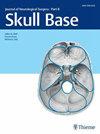Anatomical step-by-step dissection of complex skull base approaches for trainees: lateral supraorbital approach with expanded indications
IF 0.9
4区 医学
Q3 Medicine
引用次数: 0
Abstract
Abstract Objectives The lateral supraorbital (LSO) approach is a less-invasive alternative to the pterional craniotomy that provides rapid transsylvian access. Establishing familiarity with the LSO technique and its features as compared with other anterolateral approaches is an important component of advanced skull base training. We present a step-by-step demonstration of the LSO approach using cadaveric dissection in a manner that is digestible for trainees at various levels. Design This is anatomic step-by-step dissection and representative case series. Setting This study was carried out in the cadaveric dissection laboratory. Participants A formalin-fixed, latex-injected cadaveric head specimen was dissected under microscopic magnification by a neurosurgery resident under faculty supervision. Following dissection, representative case applications were reviewed. Main Outcome Measures Dissection and case illustration were the main outcome measures. Results A single-layer myocutaneous flap is developed, and a single-burr-hole technique is used, followed by extensive drilling of the sphenoid wing. The dura is opened in a C-shaped fashion centered on the Sylvian fissure, exposing the inferior frontal and superior temporal lobes. Labeled photographs of dissections with pertinent anatomical structures are presented. Three case examples illustrating the versatility of the LSO approach, including the resection of a large pituitary adenoma, an inferior frontal melanoma metastasis presenting to the Sylvian surface, and a frontoinsular low-grade glioma, are reviewed. Conclusions As compared with the pterional craniotomy, the LSO approach involves a shorter incision, smaller craniotomy, and faster exposure; it can be conveniently tailored to various indications. Understanding the step-by-step dissection and indications of the LSO approach is of paramount importance to neurosurgery trainees.受训者复杂颅底入路的分步解剖:扩展指征的外侧眶上入路
目的外侧眶上入路(LSO)是翼点开颅术的一种侵入性较小的选择,可提供快速的跨西半球入路。与其他前外侧入路相比,熟悉LSO技术及其特点是高级颅底训练的重要组成部分。我们提出的LSO方法的一步一步的示范使用尸体解剖的方式,是可消化的受训者在各个层面。设计:解剖分步解剖和代表性病例系列。本研究在尸体解剖实验室进行。一个福尔马林固定的,注射乳胶的尸体头部标本在显微镜下由神经外科住院医师在教师监督下解剖。在解剖之后,回顾了有代表性的案例应用。主要观察指标:解剖和病例说明为主要观察指标。结果建立单层肌皮瓣,采用单钻孔技术,大面积钻取蝶翼。硬脑膜以Sylvian裂为中心以c形打开,露出额下叶和颞上叶。带标签的照片解剖与相关的解剖结构提出。本文回顾了三个例子,说明了LSO入路的多功能性,包括切除大垂体腺瘤、转移到Sylvian表面的下额黑色素瘤和额岛低级别胶质瘤。结论与翼点开颅术相比,LSO入路切口更短,开颅面积更小,暴露速度更快;它可以方便地定制各种适应症。了解一步一步的解剖和适应症的LSO入路是至关重要的神经外科学员。
本文章由计算机程序翻译,如有差异,请以英文原文为准。
求助全文
约1分钟内获得全文
求助全文
来源期刊

Journal of Neurological Surgery Part B: Skull Base
CLINICAL NEUROLOGY-SURGERY
CiteScore
2.20
自引率
0.00%
发文量
516
期刊介绍:
The Journal of Neurological Surgery Part B: Skull Base (JNLS B) is a major publication from the world''s leading publisher in neurosurgery. JNLS B currently serves as the official organ of several national and international neurosurgery and skull base societies.
JNLS B is a peer-reviewed journal publishing original research, review articles, and technical notes covering all aspects of neurological surgery. The focus of JNLS B includes microsurgery as well as the latest minimally invasive techniques, such as stereotactic-guided surgery, endoscopy, and endovascular procedures. JNLS B is devoted to the techniques and procedures of skull base surgery.
 求助内容:
求助内容: 应助结果提醒方式:
应助结果提醒方式:


